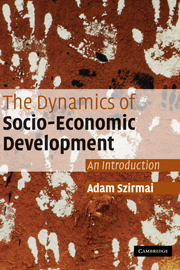Book contents
- Frontmatter
- Contents
- List of figures
- List of tables
- List of boxes
- Preface
- List of abbreviations
- Acknowledgements
- Chapter 1 Developing countries and the concept of development
- Chapter 2 Development of the international economic order, 1450–2000
- Chapter 3 Growth and stagnation: theories and experiences
- Chapter 4 Technology and development
- Chapter 5 Population and development
- Chapter 6 Health, health care and development
- Chapter 7 Education and development
- Chapter 8 Economic development, structural transformation and primary exports
- Chapter 9 Industrial development
- Chapter 10 Agricultural development and rural development
- Chapter 11 State formation and political aspects of development
- Chapter 12 Cultural dimensions of development
- Chapter 13 The international economic and political order since 1945
- Chapter 14 Foreign aid and development
- Bibliography
- Author index
- Subject index
Chapter 13 - The international economic and political order since 1945
Published online by Cambridge University Press: 05 June 2012
- Frontmatter
- Contents
- List of figures
- List of tables
- List of boxes
- Preface
- List of abbreviations
- Acknowledgements
- Chapter 1 Developing countries and the concept of development
- Chapter 2 Development of the international economic order, 1450–2000
- Chapter 3 Growth and stagnation: theories and experiences
- Chapter 4 Technology and development
- Chapter 5 Population and development
- Chapter 6 Health, health care and development
- Chapter 7 Education and development
- Chapter 8 Economic development, structural transformation and primary exports
- Chapter 9 Industrial development
- Chapter 10 Agricultural development and rural development
- Chapter 11 State formation and political aspects of development
- Chapter 12 Cultural dimensions of development
- Chapter 13 The international economic and political order since 1945
- Chapter 14 Foreign aid and development
- Bibliography
- Author index
- Subject index
Summary
Chapter 2 introduced the concept of an international economic order. International economic orders are characterised by typical patterns of flows of goods and services, financial capital, people and knowledge. Other characteristics include the intensity of relationships between economies and the institutional structure of these relationships. In this chapter, we discuss developments in the international order and their significance for developing countries since 1945. In addition to the economic aspects of the post-war international economic order, we deal extensively with political and institutional aspects such as the international balance of power, the role of international organisations such as the United Nations, the World Bank and the IMF, and important international conventions and treaties.
This chapter identifies four stages in the development of international economic relationships. These stages are characterised by typical patterns of regional and global growth and by dominant policy orientations. Each period ends with a major system shock, which affects not only patterns of economic development, but also theoretical and practical thinking about economic policies and development strategies. The periods are: the period of liberalisation of world trade (1944–73), the rise and eclipse of the policy goal of a New International Economic Order (1960–82), the period of debt crisis and structural adjustment (1982–97) and the period since 1997, which is characterised by a revival of the intellectual debates on globalisation and liberalisation. The three major system shocks are the oil crisis of 1973, the debt crisis of 1982 and the Asian crisis of 1997, each of which affected growth trajectories and resulted in a fundamental rethinking of development strategies.
- Type
- Chapter
- Information
- The Dynamics of Socio-Economic DevelopmentAn Introduction, pp. 515 - 579Publisher: Cambridge University PressPrint publication year: 2005



